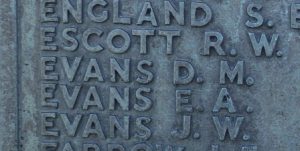Neath Rugby Football Club was established in 1871 by a consortium of ten enthusiasts and is the oldest first-class rugby club in Wales. The club has played its home games at The Gnoll since its formation. The players wore dark rugby kit during the early years, but following its change to an all black kit, became known as the ‘Welsh All Blacks’, with a white cross pattée on the breast. The change to this black strip is believed to have been introduced as a mark of respect to the player Dick Gordon, who died from injuries sustained on the field of play against Bridgend in 1880. The club has had several golden periods, most notably during the glory years of 1986 to 1996, when they became one of the most feared club sides in the world. The club was merged with Swansea RFC following the dawning of the professional era, to form a regional team and together they play as The Ospreys. Neath RFC and Swansea RFC still exist, although now as feeder clubs for the Ospreys. At the time of writing this, Neath play in the Welsh Championship and Swansea in the Welsh Premiership.
The Great War, 1914-1918
Graham Trevor Athelstan Benson, 2nd Corporal, 169, South African Railway Operating Company. George was born in 1881, the son of Thomas Benson and Emily Harriet Benson (nee Morris), of 2, Duke Street, Swansea. He was educated at Swansea Grammar School and became a renowned athlete and rugby player, playing rugby on the wing for Neath, Mountain Ash, Maesteg and Swansea. He was also a gifted swimmer who played water polo. Graham left Swansea in about 1904 to work in German East Africa. Following the outbreak of war he enlisted into the South African army, but due to his age was unable to join the infantry, so was posted to the South African Railway Operating Company. He returned to Britain and visited Swansea whilst on leave prior to being posted to the Western Front with the South Africans in the summer of 1916. Graham survived the South Africans terrible ordeal at Delville Wood, on the Somme, that summer and on the following year moved with them to the Ypres Salient. He was killed by a bomb dropped from a German aircraft whilst at work near Vlamertinghe on 26 September 1917. The 36-year-old was buried in Vlamertinghe New Military Cemetery, Belgium.
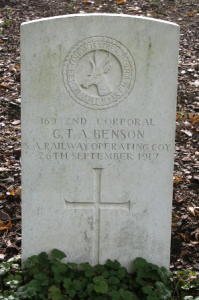
William Matthias Beynon, Sapper, 42176, Royal Engineers. William was born in 1879, the son of William Beynon and Mary Beynon, of 55, Neath Road, Llansamlet. The family later resided at Preswylfa, Wern Road, Skewen. William worked as a carpenter prior to the war and played several games for Neath RFC on the wing in the 1903-1904 season. William enlisted into the Royal Engineers at Neath soon after the outbreak of war and embarked for France on 19 July 1915 attached to the 82nd Field Company, Royal Engineers. The company was attached to the 19th (Western) Division and moved to the Nursery Sector at Calonne for trench initiation alongside the Dehra Dun Brigade. The infantry battalions of the division then began carrying out the usual routines of rotating in the trenches: four days in the front line; four in support; and four in reserve, interspersed with training regimes and carrying out working parties and trench raids. Just south, the British launched a great offensive around the town of Loos on 25 September 1915, and the 19th Division was ordered to attack from its positions at the same time, to attempt to draw enemy attention away from the main battle area. The attacking battalions of the 19th Division were in place by 04.00, and then at 05.50 the men climbed out of their trenches to launch their assault, behind a gas and smoke screen. The assault was a disaster, and heavy casualties were suffered by the 19th Division for no gain. The Division remained in Flanders until being relieved at the end of April 1916 and moved into the rear areas around Flesselles for training, then in the middle of June moved into the Somme sector, near Albert, where it took part in the second wave of the attack on Ovillers-La Boiselle on 2 July, capturing the village at heavy cost and remained in the line for several days before being relieved. After a brief rest the 19th Division then moved into the shattered remains of Mametz Wood on 21 July, in readiness for another assault, moving into positions at Bazentin-le-Petit on 23 July. The men worked hard over the coming days, digging new communication trenches, in terrible conditions and heavy casualties were suffered over the coming days as the fighting raged. After a brief rest the 19th Division then took part in an assault from the Heligoland Trenches against Contalmaison in daylight behind a creeping artillery barrage, the first time this strategy was used, suffering heavy casualties again, but reaching the outskirts of the village. The division was then relieved and moved back behind the lines to rebuild, in bivouacs at Baisieux Wood whilst heavy fighting continued around Ovillers and Trônes Wood. During the last few days of September and the first week in October, the British made notable advances to the north of Thiepval and towards Bapaume, capturing the villages of Le Sars and Eaucourt L’Abbaye. Winter then fell upon the Somme, yet the fighting raged on and British attention turned towards the Ancre valley. The 19th Division, which had moved to the Bailleul area to refit, was brought back south at the beginning of October and took part in the final operations which ended with the capture of Beaumont Hamel. On 18 November 1916, William’s company received orders to erect four footbridges across the river Ancre, to link up with the recently captured Bainbridge Trench. The men advanced and began laying down the bridges, but suffered casualties from friendly artillery fire. William was killed in action on the Ancre that day. The 36-year-old has no known grave and is commemorated on the Thiepval Memorial, France.
Capel Lisle Aylett Branfill, Captain, Glamorgan Yeomanry. Capel was born in Brazil on 29 August 1884, the son of Capel Aylett Branfill and Gwladys Gwendoline Branfill (nee Miers), of The Plas, Crickhowell. The family traced their lineage from the Plantagenet Kings. Upon returning to Wales, Capel was educated at Harrow and played rugby for the school. He married Susannah Hamilton Williams at Napleton Church, Upton Upon Severn on 26 March 1913, and the couple set up homes at Ynistawe, Clydach and in Kempston, Worcestershire. Capel was an estate agent and had played for Neath RFC prior to the war. He was a serving officer with the Territorial Army, having been commissioned into the Glamorgan Yeomanry on 19 April 1909, and by the time that war erupted had been promoted to Captain. The Glamorgan Yeomanry mobilised at Bridgend in August 1914 as part of the South Wales Mounted Brigade, before the brigade moved to Hereford. At the end of August the Brigade moved to the Thetford area, joining the 1st Mounted Division, and then to Aylsham on coastal defence duties. In October 1915 the 1st Mounted Division moved to the Cromer area, where it was dismounted, and in March 1916 embarked for Egypt, being placed on the Suez Canal Defences. On 20 March 1916 the South Wales Mounted Brigade was absorbed in the 4th Dismounted Brigade. By now Capel was struggling with the harsh conditions and his health was deteriorating. He took ill and succumbed to pneumonia in the 1st Red Cross Hospital at Cairo on 11 May 1916. The 31-year-old is buried in Cairo War Memorial Cemetery, Egypt. Capel’s short life was full of tragedy. His wife, Susannah Hamilton Williams, was so distressed at the thought of him going to the front, that she tragically drowned herself and their infant child, Gwendoline, in a pool near her parent’s home at Upton upon Severn on 24 January 1915.
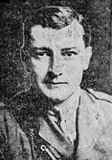
Reginald Gordon Snell Browning, Captain, Welsh Regiment. Reginald was born on 26 October 1886, the son of Robert Alexander Browning and Beatrice Elizabeth Browning (nee Snell), of The Corporation Gas Works, Neath. His father was the chief engineer at the gas works and upon leaving school, Reginald joined him there, working as a clerk. Reginald was a keen member of the Territorial Army prior to the war, serving with the 6th Battalion, Welsh Regiment, and played in the forwards for Neath RFC. The 6th Battalion, Welsh Regiment was one of the first territorial units to move to France in August 1914. Initially, in late 1914 and early 1915, they were on lines of communication and in July 1915 were based in the Locre and Kemmel area, facing the Germans who were on the high ground at Spanbroekmolen. The battalion was in the trenches, but also doing work repairing trenches etc. On 5 July 1915 the battalion was attached to 84 Brigade, 28th Division, alongside the 1st Battalion, Welsh Regiment. On 21 September the Battalion marched off towards Vermelles and on 1 October 1916 was thrown into the Battle of Loos, a terrible battle which had already seen the 2nd Welsh decimated. The 28th Division had been put into the line to resume the stalled offensive and became caught up in a ferocious hand-to-hand fight in the trenches. Reginald was last seen by one of his men being taken prisoner by the Germans near Little Willie Trench on 2 October 1915, but he was later found to have been killed in action that day. The 6th Welsh had also suffered the loss of its CO, Lieutenant-Colonel Lord Ninian Crichton-Stuart during the day. Reginald was 29 years old when he was killed at Loos. He has no known grave and is commemorated on the Loos Memorial, France.
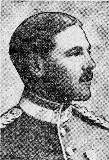
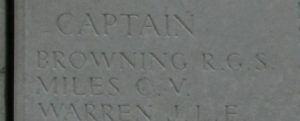
David Benjamin Davies, Sergeant, 197036, Royal Garrison Artillery. David was born in 1882, the son of Reverend William Dyfodwg Davies and Joanna Davies, of Crown Street, Llangyfelach. He had played football for Morriston before becoming a regular member of the Neath RFC team, where he played in the centre and on the wing. David became a teacher after leaving school and married Edith Gertrude Morris at Morriston on 27 December 1906. The couple then moved to 8, Alexandria Street, Mountain Ash after David gained a position as assistant master in a school there, and he began playing rugby for Mountain Ash. David enlisted into the Royal Artillery at Cardiff on 13 February 1915 and was posted to the 122nd Brigade, Royal Field Artillery, which was attached to the 43rd (Welsh) Division. The brigade was one of three formed for the new Welsh Division and trained in North Wales. The division was renumbered to the 38th (Welsh) Division early in 1915, before moving to Morn Hill Camp, Winchester to complete its training. The Division began moving to France on 2 December 1915 and moved to the Nursery Sector near Fleurbaix for trench initiation alongside the Guards Division. The Division then held a sector of the line near Cuinchy before marching south to the Somme sector in June 1916 to take part in the assault on Mametz Wood. The first attack on the wood was launched on a two-battalion front on 7 July, but failed, and the Divisional Commander, Sir Ivor Philipps, was replaced before the Division attacked again on a two Brigade front on 10 July 1916. After two days of ferocious hand-to-hand fighting, the wood was cleared up to its northern edge, before the battered Division was relieved. It then took over a section of the front at Hébuterne before moving to the Ypres Salient, and taking over the Canal Bank sector at Boesinghe. The infantry battalions of the Division then began carrying out the normal pattern of rotation in the trenches, four days in the front, four in support and four in reserve, whilst also working on trench improvement, digging new trenches, and also carrying out regular patrols and trench raids. By now David had risen to the rank of Sergeant and was serving with the 38th (Welsh) Division Ammunition Column HQ Staff. On 31 July 1917 the Division launched its famous assault on the Pilckem Ridge, capturing Iron Cross and reaching its objective of the Steenbeek, then played a supporting role in the Battle of Langemarck. The Division was transferred to the Sailly-sur-la-Lys sector in September, and remained in the area over the winter. At the end of March 1918 the division was transferred south to positions north of Albert, at Bouzincourt Ridge, relieving the battered 2nd and 47th Divisions, however the Divisional Artillery remained in Flanders, to counter the growing threat of a German offensive in the Lys Valley. The Germans then launched a great offensive here on 9 April 1918, smashing the Allied lines and beginning a lengthy spell of desperate fighting. The 38th Divisional artillery was still in the Sailly Sector when the Germans hit, and lay covering fire down on the Houplines Sector, whilst the Portuguese Division in front broke and fled, forcing the men to withdraw their guns back towards the river to Pont Nieppe. Heavy fighting continued on the following day whilst the artillery supported the 34th Division which was struggling to hold the line, and after the Germans captured Le Bizet, the guns were forced to withdraw again, to Neuve Eglise, where it began firing upon the Germans on the front between Steenwerck and Neuve Eglise. On the following morning, 11 April 1918, the guns were forced to withdraw again, moving behind Ravelsburg Hill, where it covered the withdraw of 88 Brigade, 29th Division. Heavy casualties were suffered by the 38th Divisional Artillery before it was eventually transferred to the Somme to re-join the rest of the division, then on 21 August 1918 onwards, the division launched its great offensive across the river Ancre, before advancing across the old 1916 battlefields towards the Hindenburg Line. David was wounded early in September and was evacuated back to the 3rd Canadian Casualty Clearing Station, at Varennes, where he died of his wounds on 16 September 1918. The 36-year-old is buried in Varennes Military Cemetery, France.
Joseph Davies, Sergeant, S/3087, Rifle Brigade. Joseph was born in 1891, the son of Thomas Davies and Margaret Davies (nee Rees), of 50, Llantwit Road, Neath. He worked as a coalminer at Seven Sisters prior to the war and had joined Neath from Resolven, playing at forward for both clubs. Joseph had enlisted at Neath together with several other local men into the 12th Battalion, Rifle Brigade soon after the outbreak of war. The battalion had formed at Winchester in September 1914, moving to Blackdown to join 60 Brigade, 20th (Light)Division, then in February 1915 moved to Witley, before completing its training at 1915 Lark-Hill. On 22 July 1915 Joseph landed at Boulogne with the battalion, and the entire 20th (Light) Division moved to the Fleurbaix Sector for trench familiarisation and training. When the Battle of Loos was launched on 25 September 1915 the Division fought a diversionary attack towards Fromelles, suffering heavy casualties for no gain. Following the attack the division spent the coming months holding the line in the L’Epinette Sector, where the battalions received drafts of reinforcements. After a relatively quiet Christmas period, at the end of January 1916 the division was relieved and had a short rest behind the lines, then by 5 February arrived at Poperinghe, ready to take up new positions in the line north of Ypres, along the Canal Bank at Boesinghe. On the night of 11 February 1916, the 12th Rifle Brigade moved into the front line here to begin their first tour in the new positions, relieving the 9th KRRC. At 02.00 on the following morning, whilst the relief was still underway, the Germans attacked the positions, using grenades and artillery, before the German infantry began fighting their way through the trenches. Joseph was killed in action during the fighting which ensued, on 12 February 1916. The 24-year-old has no known grave and is commemorated on the Ypres (Menin Gate) Memorial, Belgium.
John Enos Griffiths, Second Lieutenant, Gloucestershire Regiment. John was born in 1893, the son of John Griffiths and Jane Charity Griffiths (nee George), of 46, London Road, Neath. The family had moved to 80, Gnoll Park Road, Neath by 1911 and John was assisting his father in the family coal and coke exporting business. He was a renowned sportsman, playing cricket for Neath Cricket Club and began appearing at full back for Neath RFC in 1913. John enlisted into the Inns of Court Officer Training Corps and was commissioned from the OTC as Second Lieutenant into the 2/5th Battalion, Gloucestershire Regiment on 28 November 1917. The battalion was attached to 184 Brigade, 61st (South Midland) Division and was holding a section of the line in the Villers-Plouich area when John arrived in France. During the coming weeks it became to become common knowledge among the British that the Germans were planning an attack, so the men were kept busy working on strengthening the defensive positions, and the 2/5th Gloucester’s worked hard in their forward zone around Holnon. The battalion was in Holnon Wood when the Germans opened the first phase of their great Spring offensive at dawn on 21 March 1918. Following a tremendous artillery barrage, highly trained German stormtroopers attacked along the section of front running south from Croisilles to La Fère, breaking the line in several places and forcing the Allies to withdraw. The division suffered heavy losses as it fought a stubborn rearguard action back over the Somme crossings over the next ten days. The battered division was then transferred north to St. Venant to rest, but the Germans launched the second phase of their offensive here just weeks later, on 9 April 1918, and the division became caught up in the thick of the fighting once again, firstly during its dogged defense of the St. Floris Sector over the coming days. On 23 April 1918 the 2/5th Gloucester’s were holding the line at Baquerolles when the Germans attacked in great strength, supported by a heavy artillery barrage. John was killed in action during the fighting that day. The 25-year-old is buried in St. Venant-Robecq Road British Cemetery, Robecq, France.
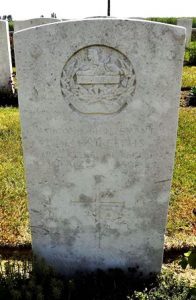
Rees Hill, Rifleman, S/3081, Rifle Brigade. Rees was born in 1888, the son of Joseph Hill and Elizabeth Hill (nee Jenkins), of 37, Bowen Street, Neath. He worked as a collier prior to the war and was a highly regarded rugby player, who had captained the Melyn Barbarians side and had played for Neath RFC prior to the war. Rees married Mary Lilian Thomas, of 15, Richmond Terrace, Penrhiewlyn, Neath on 10 September 1914. He enlisted into the Rifle Brigade soon afterwards and was posted to the 9th Battalion, Rifle Brigade. The battalion had formed at Winchester in August 1914, moving to Aldershot to join 42 Brigade, 14th (Light) Division, then moved to Petworth in November 1914 before returning to Aldershot in February 1915. Rees then embarked for France with the battalion on 20 May 1915, and disembarked at Boulogne, before the entire 14th Division moved to Flanders, prior to moving into the Ypres Salient, before taking over positions in the Zillebeke Sector on 20 June. The Division was to see its first action during the Action of Hooge on 30 July, where the Division became the first to be attacked by the German use of flamethrowers. The division then fought at the Second attack on Bellewaarde on 25 September 1915, a diversionary attack intended to draw German attention away from the main assault to the south at Loos, but suffered heavy casualties for no gain. The division remained at Ypres over the coming months before being relieved and moved south to the Somme in July 1916 to join the great Somme offensive. By now Rees’s health had begun to suffer from the terrible conditions in the trenches at Ypres and he was diagnosed as suffering from diabetes before being discharged from the army as medically unfit on 15 September 1916, returning home to his wife at Neath. Rees sadly died due to his diabetes at home on 11 December 1917. The 29-year-old was buried in Ynysmaerdy Cemetery, Neath.
Richard John Hughes, DCM, Private, 7374, Somerset Light Infantry. Richard was born in Merthyr in 1886. He appears to have been orphaned as a young child and on 10 May 1887 had been admitted into Neath Union Workhouse and was brought up there. On 20 October 1902 Richard enlisted at Neath into the Welch Regiment. He had left the army by 1908 and married Sarah Emma Davies, at Neath. The couple then settled at 1, Strick’s Court, Neath, where their five children were born over the coming years. Richard worked as a collier and had been a regular in the backs for Neath RFC side prior to the war. As a former soldier, he was an Army Reservist, and was mobilised at Neath soon after the outbreak of war, joining the 1st Battalion, Somerset Light Infantry, which was at Colchester, attached to 11 Brigade, 4th Division. The division swiftly embarked for France, landing at Le Havre on 22 August 1914, before entraining for the Belgian frontier and arrived just in time to join the hard-pressed Divisions of II Corps at The Battle of Le Cateau. The Division then took part in the epic retreat to the Marne, where the German Offensive was halted, and in the advance to the Aisne. The Division was then moved north to Flanders with the BEF, and took part in the Battle of Messines, where Units of 4th Division took part in the famous Christmas Truce while they were still in this area, in trenches near Ploegsteert Wood. In 1915 the Division fought at the Second Battle of Ypres. Richard gained his first recognition of his gallantry at Ypres, where he was recommended for the Distinguished Conduct Medal for stalking and killing a German sniper who had been harrassing their positions. The first award was not granted, but within months Richard would finally gain the award of the Distinguished Conduct Medal for another fine act of gallantry. In the meantime he had been wounded at Ypres and came home on leave in July 1915, to a grand reception, and upon his return to the front was posted to the 8th Battalion, Somerset Light Infantry, which was attached to 63 Brigade, 37th Division. It was whilst with the 8th Battalion that Richard finally gained his much deserved award. The citation was published in the London Gazette of 11 March 1916, which read: ‘For conspicuous gallantry; he brought in two wounded men under heavy shell fire. He has invariably displayed great bravery and skill in most useful reconnaissance work throughout the campaign.’ He returned home again on leave in August 1916, to another fine reception, and upon his return to France once again was posted to the 7th Battalion, Somerset Light Infantry, which was attached to 61 Brigade, 20th (Light) Division, on the Somme. The division saw heavy fighting throughout the Somme offensive and and took part in the advance to the Hindenburg Line in March 1917. Later that year the division moved to the Ypres Salient and fought during several major battles during the Passchendaele offensive, before moving south again, to take part in the great Cambrai offensive. On 20 November 1917 the division attacked La Vacquerie, supported by a squadron of tanks. The German line was broken and the Hindenburg Line breached, but the Germans swiftly reorganised and counterattacked on 30 November 1917. Richard was killed in action during heavy fighting near Masnieres that day. The 31-year-old has no known grave and is commemorated on the Cambrai Memorial, Louverval, France.
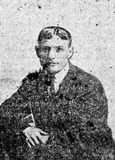
William Jarrett, MM, Private, 48503, Devonshire Regiment. Richard was born in 1877, the son of William John Jarrett and Hannah Jarrett (nee Davies), of Tircimla Farm, Cimla, Neath. He worked as a behinder in a local tinworks and had played in the forwards for Neath RFC and for Neath 2nd XV prior to the war. William enlisted into the army and was drafted out to France in the summer of 1917 to join the 9th Battalion, Devonshire Regiment. The battalion was attached to 20 Brigade, 7th Division and The division had suffered terrible casualties at Bullecourt and then at Polygon Wood by the time William arrived, but was relieved on 26 October and was moved to Italy, being one of the British Divisions selected to come to the support of the Italian army. William was then transferred to the 1st Battalion, Devonshire Regiment, which was also in Italy, and was attached to 95 Brigade, 5th Division. Following the launching of the German spring offensive along the Somme front on 21 March 1918, the division was hurriedly recalled to the Western Front, moving to positions defending the Nieppe Forest, and saw heavy fighting over the coming weeks. On 14 August, the 5th Division was withdrawn for rest and placed in GHQ Reserve, before moving back into the line near Sailly au Bois and on 21 August 1918 took part in the opening phase of the great Allied advance to victory, helping capture Achiet-le-Petit. William was awarded the Military Medal for bravery in the field for his efforts during the heavy fighting over the coming days, but was wounded during the advance to the Hindenburg Line and was evacuated back to Britain. He was taken to a hospital near Stoke-on-Trent for treatment, but sadly died of his wounds there on 29 October 1918, less than two weeks prior to the Armistice. The remains of the 40-year-old were conveyed home and he was buried in Llantwit Cemetery, Neath.
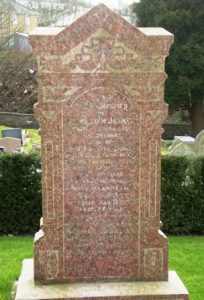
Walter Lewis Jenkins, Third Engineer, Mercantile Marine. Walter, known as Lewis, was born in 1882, the son of Walter Jenkins and Mary Jenkins (nee Evans), of 48, Peniel Green, Neath Road, Llansamlet. He resided at 159, New Road, Skewen prior to the war and married Elizabeth Anne James at Aberystwyth on 25 August 1914. Lewis had played rugby at centre for Neath and for Swansea as a young man but following the outbreak of war left the town to attempt to enlist into the Royal Field Artillery. He failed to enlist for some reason, and instead enlisted into the Mercantile Marine as an engineer. Walter was then given the rating of Third Engineer and was posted aboard the Swansea registered steamer, SS Tangistan. The ship arrived back in Swansea from Benisaf, North Africa and Lewis was among a number of Swansea men who were posted aboard her, for a trip to Middlesborough. At about half past midnight on 9 March 1915, Tangistan, steaming off Flamborough Head, was hit by a torpedo which had been fired from the German submarine U-12. Before the crew had a chance to launch her lifeboats, Tangistan went down with the loss of all bar one of her crew of 38 men. Lewis was 32 years old when he drowned aboard Tangistan that morning. He has no known grave and is commemorated on the Tower Hill Memorial, London.
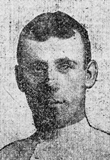
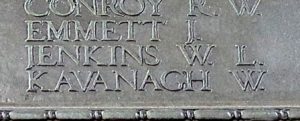
Gwilym Jones, Second Lieutenant, Lincolnshire Regiment. Gwilym was born in 1888, the son of William Jones and Eleanor Jones, of 54, Llewellyn Street, Pontygwaith. Upon leaving school he trained as a schoolteacher, before gaining a position at Tylorstown. Gwilym was a renowned rugby player, having played as three-quarter in the Neath championship winning side of 1909-10 and in 1910-11. He had also played for Pontypridd, Cardiff, London Welsh and for Glamorgan County. Gwilym married Margaret Anne Gobert, of Aberystwyth, in 1915 and the couple had a son, Gwilym, born in Tylorstown in 1916. Gwilym originally enlisted as a private into the 3rd Battalion, Welsh Regiment, then on 14 January 1918 was commissioned as Second Lieutenant into the Lincolnshire Regiment. Gwilym was not drafted to France until the summer, when he joined the 8th Battalion, Lincolnshire Regiment in the Arras sector on 13 August 1918. The battalion was attached to 63 Brigade, 37th Division and was in the trenches in front of Bucquoy when Gwilym arrived. Four days later, after a quiet spell in the line, the battalion was relieved and moved into reserve at Souastre. By now the Allies were set for a great offensive along this sector of the line, and at dawn on 21 August 1918 the 8th Lincolns took part in a frontal assault on Bucquoy from the direction of Pigeon Wood. Over the coming days the division captured Achiet-Le-Grand and Bihucourt, as the Allies began driving the Germans back towards the Hindenburg Line, crossing the Bapaume Road as the Germans were driven back. By 5 September the 37th Division had reached Havrincourt Wood, and two days later began driving forward again. Gwilym was killed in action during an assault on Knife Trench on 10 September 1918. The 31-year-old was buried in Hermies Hill British Cemetery, France. His son, Gwilym Louis Gobert Jones, was killed at sea in 1940.
Thomas Jones, Corporal, 12633, Welsh Regiment. Thomas was born at Neath in about 1877. Thomas had enlisted at Neath into the Welsh Regiment in November 1896 and had served in South Africa during the Anglo-Boer War of 1899-1902 and then in India. Upon leaving the army he returned home and found work at the Main Colliery, Bryncoch. Thomas had been a regular player at outside half for Neath RFC prior to the war. His only named next of kin was his sister, Mrs Annie Davies, of 25, Bethlehem Road, Skewen. Thomas re-enlisted into the Welsh Regiment when war broke out and was posted to the 8th Battalion, Welsh Regiment. The battalion was formed at Cardiff in August 1914, moving to Salisbury Plain to join 40 Brigade, 13th (Western) Division. The battalion moved to Chiseldon in October then in December moved again to billets in Bournemouth, where it became converted to the Pioneer Battalion to the 13th Division. In February 1915 the division moved to Aldershot to complete its training, then on 15 June 1915 sailed from Avonmouth for Mudros, before being landed ashore at Anzac, Gallipoli on 5 August 1915, to fight alongside the Anzacs in a great diversionary attack. The 8th Welsh, now reverting to its infantry role, marched out from Anzac Cove on the following day and took up reserve positions at the mouth of Chailak Dere. The 13th Division launched a great assault on Chunuk Bair on 7 August and took its objectives, despite heavy losses, so at dawn on 8 August 1915 the 8th Welsh moved forwards, supported by the heavy guns of the ships deployed offshore. As the battalion crossed Apex Ridge, the men were mown down by heavy machine-gun fire and was almost decimated. Thomas was killed in action during the day, on 8 August 1915. The 38-year-old has no known grave and is commemorated on the Helles Memorial, Gallipoli.
Thomas Owen Jones, Corporal, 20970, Welsh Regiment. Thomas was born in 1887, the son of Thomas Jones and Catherine Jones, of 36, High Street, Treorchy. He had worked as a collier and played on the wing for Neath RFC and for Glamorgan as a young man, then in December 1913 signed for the Rugby League side, Oldham, and went to play as a professional, making 46 appearances for the club. Thomas was lodging at 37, Redgrave Street, Oldham when war broke out and on 29 September 1915 enlisted into the 10th Battalion, Manchester Regiment, a Territorial Army battalion. He then volunteered to transfer into the regular army and on 21 April 1915 joined the 15th Battalion, Welsh Regiment, which had recruited heavily in the nearby Bolton area. Thomas joined the 15th Welsh at Rhyl, but was then transferred to the 3rd Battalion, Welsh Regiment at Redcar. He was drafted to France on 3 March 1916 and was posted to the 9th Battalion, Welsh Regiment, which was in Flanders attached to 58 Brigade, 19th (Western) Division. The division moved south to the Somme in June 1916 and on 1 July 1916 joined the great push to capture the villages of Ovillers and La Boiselle. Suffering severe casualties over the coming days the division was relieved and after a brief rest took part in an assault from the Heligoland Trenches against Contalmaison in daylight behind a creeping artillery barrage, the first time this strategy was used. The division suffered heavy casualties again, but reached the outskirts of the village. The division was then relieved and moved back behind the lines to rebuild, in bivouacs at Baisieux Wood whilst heavy fighting continued around Ovillers and Trônes Wood. During the last few days of September and the first week in October, the British made notable advances to the north of Thiepval and towards Bapaume, capturing the villages of Le Sars and Eaucourt L’Abbaye. Winter then fell upon the Somme, yet the fighting raged on and British attention turned towards the Ancre valley. The 19th Division, which had moved to the Bailleul area to refit, was brought back south at the beginning of October and took part in the final operations which ended with the capture of Beaumont Hamel. On 26 October the 9th Welsh relieved the 9th Loyals in the Stuff Redoubt trenches, and endured a very trying period in the line. The Division wintered on the Somme and in February followed the German withdrawal to the Hindenburg Line. During the middle of March 1917 the Division was relieved from the line and began to move north, taking over positions in the Ypres Salient, and on 7 June took part in the assault on Messines Ridge, which was famously preceded by the blowing of a series of 19 huge underground mines. The 19th Division saw heavy fighting during the battle, then enjoyed a short spell in reserve before moving back into the line on 11 September, taking over a section of trenches running from the Ypres-Comines Canal to Belgian Wood. On 20 September the 9th Welsh took part in an attack by the Division, past Hollebeke Chateau, to Hessian Wood. The 9th Welsh alone suffered around 300 casualties during the costly attack. Thomas had been killed in action during the attack that day. The 30-year-old has no known grave and is commemorated on the Tyne Cot Memorial, Belgium.
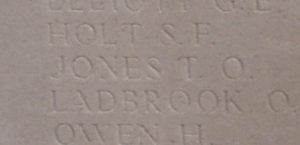
Charles Morris, Private, 6072, Royal Welsh Fusiliers. Charles was born in 1880, the son of Henry Morris and Phoebe Morris (nee Jones), of 20, Walter’s Road, Melincrythan, Neath. He had served with the old Militia as a young man and had seen action in South Africa during the Anglo-Boer War of 1899-1902. Charles worked as a gas fitter and had played full back for Neath RFC. As a former soldier, Charles was an Army Reservist, and he was mobilised on 4 August 1914, travelling to Wrexham to join the 3rd Battalion, Royal Welsh Fusiliers. Charles was drafted to France on 2 November 1914 and joined the 1st Battalion, Royal Welsh Fusiliers, which was in the Ypres Salient, attached to 22 Brigade, 7th Division. The division had suffered terrible casualties during the preceding weeks, following the German attacks on Ypres, which had begun on 19 October. Following the closure of the First Battle of Ypres, the 7th Division moved to positions near Neuve-Chapelle, to rebuild in a quieter sector. Charles was one of two men wounded during a routine spell in the trenches here on 11 December and was evacuated to safety, but died of his wounds on the following day, 12 December 1914. The grave of the 34-year-old was lost at sometime during the war, so he is commemorated on the Ploegsteert Memorial, Belgium.
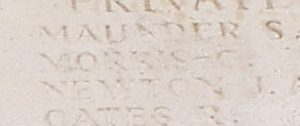
James Morris, Lieutenant, Welsh Regiment. James, known as Jim, was born in 1892, the son of David John Morris and Anne Morris (nee Jones), of Sea View, Birchgrove, Swansea. He was a well-known athlete in the town and played at centre for the Swansea and Neath Rugby teams. James enlisted into the 3/1st Battalion, Glamorgan Yeomanry soon after the outbreak of war. The battalion formed as a reserve battalion early in 1915 and in the summer became attached to a reserve cavalry regiment at the Curragh. James was commissioned into the 13th (Reserve) Battalion, West Yorkshire Regiment on 16 November 1915, before transferring back as a Second Lieutenant into the Glamorgan Yeomanry on 16 April 1916. The 1/1st Glamorgan Yeomanry had recently embarked for Egypt together with the Pembroke Yeomanry as part of the South Wales Mounted Brigade but was dismounted and reverted to an infantry battalion as soon as it arrived, and the Brigade became entitled the 4th Dismounted Brigade. The new Brigade took up positions on the Suez Canal Defences, whilst also patrolling to counter the threat of local Senussi Tribesmen. On 2 February 1917 the Glamorgan Ye4omanry merged with the Pembroke Yeomanry to form the 24th Battalion, Welsh Regiment, and became attached to 231 Brigade, 74th (Yeomanry) Division. The Division assembled in Egypt as part of the EEF, before crossing the Suez Canal into the Sinai, and saw its first major action during the Second Battle of Gaza. The battle was a failure, and the EEF was re-organised under a new commander, Sir Edmund Allenby, before launching the Third Battle of Gaza on the night of 31 October 1917. This assault was launched along a winder front, running from Gaza to Beersheba, and this time the EEF prevailed, opening the door to Jerusalem. Following the surrender of Jerusalem to Allenby’s forces on 9 December, the EEF continued to advance northwards, but became hit by a series of Turkish counterattacks. On the night of 26-27 December, the Turks launched attacks against the 60th and 53rd Divisions, whilst the 24th Welsh launched an assault on Hill 1910, north of Beit Duqqu. After fierce hand to hand fighting the Welshmen captured their objectives, but a Turkish counterattack drove them off before they had time to consolidate their gains, and the 24th Welsh had to attack again, ultimately driving the Turks away. James was killed in action during the fighting of 27 December 1917. The 25-year-old is buried in Jerusalem War Cemetery, Israel.
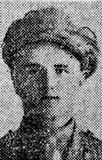
Thomas Owen, Sergeant, 14606, Welsh Regiment. Thomas was born in 1893, the son of John Watkin Owen and Elizabeth Owen, of Wellfield, Resolven. He worked as a fitter for Cory Brothers at Resolven and was a highly regarded winger, who joined Neath RFC from Resolven, and had then played for Glamorgan County. As soon as war erupted, Thomas enlisted at Neath into the 9th Battalion, Welsh Regiment. The battalion had formed at Cardiff in September 1915, moving to Salisbury Plain to join 58 Brigade, 19th (Western) Division. The battalion embarked for France with the division on 18 July 1915, and the division moved to positions north of Loos in the Givenchy area, to begin trench initiation and training. The division then took part in a very costly diversionary attack here on 25 September 1915, intending to draw German attention away from the main assault at Loos. The Division remained in Flanders until being relieved at the end of April 1916 and moved into the rear areas around Flesselles for training, then in the middle of June moved into the Somme sector, near Albert, where it took part in the second wave of the attack on Ovillers-La Boiselle on 2 July, capturing the village at heavy cost and remained in the line for several days before being relieved. After a brief rest the 19th Division then moved into the shattered remains of Mametz Wood on 21 July, in readiness for another assault, the 9th Welsh moving into positions at Bazentin-le-Petit on 23 July, in support of the 9th RWF. The men worked hard over the coming days, digging new communication trenches, in terrible conditions. The Division saw further fighting on the Somme, before winter set in, and in February followed the German withdrawal to the Hindenburg Line. During the middle of March 1917 the Division was relieved from the line and began to move north, taking over positions in the Ypres Salient, and on 7 June took part in the assault on Messines Ridge, which was famously preceded by the blowing of a series of 19 huge underground mines. Thomas was killed in action that day, during the assault by the 9th Welsh at Messines. The 24-year-old is buried in Voormezeele Enclosure No. 3, Belgium.
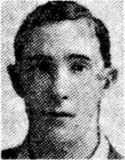
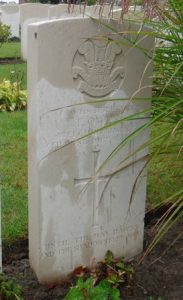
Fred Leonard Perrett, Second Lieutenant, Royal Welsh Fusiliers. Fred was born on 9 May 1891, the sson of George Perrett and Emma Perrett (nee Polgrass), of Hunter Street, Briton Ferry. He originally played rugby at hooker and prop for Briton Ferry before playing for Neath and won his first Welsh cap from Neath against the touring South African team in 1912. He was selected for Wales in the 1913 Five Nations Championship and played every game before turning professional at the end of the 1912‒13 season and then joined Leeds rugby league team, making his debut on 6 September 1913, and later played for Hull. Fred married Nora Gladys Dougherty in the autumn of 1915 and the couple resided at 118 St. George’s Road, Hull, where their two sons were born. He enlisted into the Welsh Guards and served in France from 19 February 1916 and was recommended for a commission following some sterling work on the Somme, returning to Britain to join an Officer Cadet Corps at Bristol University. Fred was commissioned as Second Lieutenant into the Royal Welsh Fusiliers on 27 June 1917 and was posted to France some weeks later, joining the 17th Battalion, Royal Welsh Fusiliers, which was attached to 115 Brigade, 38th (Welsh) Division. Fred joined the 17th RWF in the Sailly-sur-la-Lys sector on 2 October 1917. The division ahd moved here following its succesful assault on the Pilckem Ridge on 31 July and was in the process of rebuilding. It remained in the area over the winter before being moved to positions north of Albert, at Bouzincourt Ridge, at the end of March 1918, relieving the battered 2nd and 47th Divisions. It held this sector, again carrying out minor operations and trench raids, over the coming months, before taking part in the great offensive of 21 August 1918, and began its advance towards the Hindenburg Line, as part of the greater Allied offensive, and over the coming days captured Thiepval Ridge, Pozieres, Mametz Wood and High Wood, whilst advancing across the old Somme battlefields of 1916. The advance saw the Division take part in several costly assaults over the coming weeks, famously crossing the Canal du Nord, and then once the Hindenburg Line had been breached, the Division advanced north-east, past Le Cateau, towards the Forest of Mormal, forcing the crossing of the River Selle. Fred was seriously wounded during an assault against the Forest of Mormal on 4 November and was evacuated to a hospital near Boulogne, where he died of his wounds on 1 December 1918. The 27-year-old is buried in Terlincthun British Cemetery, Wimille.
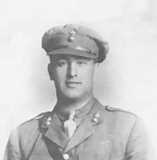
Thomas Powell, DCM, Captain, Royal Irish Regiment. Thomas was born in Neath in about 1869. He had been a regular player for Neath RFC in the 1890’s and had been twice mentioned in despatches and awarded the Distinguished Conduct Medal for his gallantry whilst serving in South Africa during the Anglo-Boer War of 1899-1902 whilst serving as Quartermaster Sergeant with the Royal Warwickshire Regiment. Following the outbreak of the Great War, Thomas re-enlisted and became Quartermaster and Lieutenant with a battalion of the Oxford & Buckinghamshire Light Infantry. Thomas was invalided home in 1917 and upon recovering his health was posted out to Ireland to join the 2nd Garrison Battalion, Royal Irish Regiment. Thomas became ill during the following summer and died in hospital in Dublin on 1 July 1918. The 49-year-old was buried in Grangegorman Military Cemetery, in Dublin.
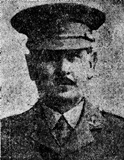
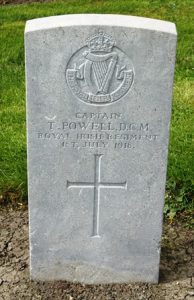
Rosser David Rosser, Private, 14807, King’s Shropshire Light Infantry. Rosser was born on 3 March 1885, the son of Richard Rosser and Jane Rosser (nee Phillips), of 5, Rosser Street, Neath. He was the secretary of the Neath Thursdays prior to the war, and played a prominent role in rugby in the town. Rosser worked for the staff of the Great Western Railway as a young man, before becaming a partner in the firm of Vaughan and Rosser, Engineers, at Somerville Place, Neath. Rosser enlisted at Neath into the 7th Battalion, King’s Shropshire Light Infantry soon after the outbreak of war. The battalion formed at Shrewsbury before moving to Codford, Salisbury Plain, joining 67 Brigade, 25th Division, before moving into billets at Bournemouth. The Division moved to Romsey in May, then Aldershot the following month, before embarking for France and landed at Boulogne on 28 September 1915, before moving to positions near Ploegsteert Wood. Two weeks later the 7th KSLI transferred to 8 Brigade, 3rd Division. The Division was at Ypres at the beginning of 1916, and the 7th KSLI saw its first major action at the Bluff and the St. Eloi craters, following the blowing of two underground mines by the Germans. On 1 July 1916 the Division left the Ypres Salient and began to move south to the Somme, to join the great Somme offensive. The Division reached the ruins of Carnoy by 7 July and the battalions reconnoitred the line prior to moving forward into the trenches the following day. During the morning of 14 July 1916, the Division launched its first assault on the Somme, with 8 Brigade launching an attack against Bazentin-le-Grand. The assault failed due to uncut barbed wire holding up the men in No Man’s Land and the survivors were forced to withdraw. Rosser was killed in action during the fighting that day. The 31-year-old has no known grave and is commemorated on the Thiepval Memorial, France.
World War Two, 1939-1945
Caradoc Davies, Private, 3976129, Welch Regiment. Caradoc was born in 1921, the son of Thomas Davies and Martha Davies (nee Jones), of Cwmgwrach. He had played at centre for Neath RFC prior to the war. Caradog enlisted into the army soon after the outbreak of war and was posted to the 4th Battalion, Welch Regiment. The battalion was the Carmarthenshire Territorial Army infantry battalion and was attached to the 160th Brigade, 53rd (Welsh) Division. The battalion was mobilised at the outbreak of war, when the Division moved to Northern Ireland to begin garrison duties. The Division then moved to Pembroke Dock, before moving again to the south of England, where it trained in readiness for the D-Day Landings. Caradoc married Eleanor Elizabeth Dady whilst on leave in 1942. On 23 June 1944 the division began leaving England for Normandy, and landed at La Riviere near Ver Sur Mer. The Division then took part in heavy fighting over the coming weeks, as part of the effort to break-out of the Normandy beachhead, seeing heavy fighting at Évrecy, before starting the epic advance through Northern France into Belgium and Holland. On 15 September the Division forced the crossing of the Junction Canal North of Lommel, and continued to push westwards towards Elst, between Nijmegen and Arnhem, during Operation Market Garden. On 22 October the Division launched its famous assault on ‘s-Hertogenbosch, before continuing its advance to the German frontier. Between December 1944 and January 1945, the Division took part in the Battle of the Bulge, helping in the counterattack which helped save the Americans, who were under heavy pressure, then after the German offensive was broken, took part in heavy fighting to enter the Rhineland, taking part in Operation Plunder, the Rhine Crossings, in March 1945. Caradoc survived the war and after the surrender of Germany stayed there as part of the British Army on the Rhine. He died in Germany on 11 October 1945. The 29-year-old was originally buried in Munster Standort-Lazarett Cemetery, but in 1947 the war graves from the cemetery were all exhumed and re-interred in Munster Heath War Cemetery, Germany.
David Morgan Evans, Stoker 2nd Class, P/KX 108911, Royal Navy. David was born on 21 April 1911, the son of Morgan Evans and Elizabeth Evans (nee Edwards), of Glynneath. David played as a forward for Glynneath RFC before joining Neath RFC and his mobility saw him being signed up for Hudderfield Rugby League Team. Following the outbreak of war, David enlisted into the Royal Navy and was posted aboard the world famous battlecruiser, HMS Hood. Work to build Hood had begun during the Great War, but she was completed after the Armistice, becoming the flagship of the Battlecruiser Squadron of the Atlantic Fleet. She became a familiar name around the world in the inter-war period, taking part in many high profile visists to foreign ports. Hood was in the process of undergoing a much needed refit when war broke out, and upon completion was put to work patrolling in the vicinity of Iceland and the Faroe Islands to protect convoys and intercept German merchant raiders and blockade runners attempting to break out into the Atlantic. After sustaining damage from an aircraft attack soon afterwards, she was repaired and underwent another refit before steaming for the Mediterranean along with HMS Ark Royal and took part in the destruction of the French fleet at Mers-el-Kébir in July 1940. She then returned to Scapa Flow where she resumed her previous roles in convoy escort and patrolling against German commerce raiders. When the German battleship Bismarck sailed for the Atlantic in May 1941, Hood, together with the battleship HMS Prince of Wales, was sent out to intercept the German ship and her escorting flotilla. On 24 May 1941 the two groups came into contact in the Denmark Strait between Greenland and Iceland and began firing at each other. Hood was hit early in the battle and was set ablaze, but continued to fight, until a massive German shell hit her and detonated her magazines, ripping Hood apart. The mighty ship sank quickly, with the loss of all but three of her crew of 1,418 men. David was 30-years-old when he was lost in the sinking of HMS Hood that day. He has no known grave, so is commemorated on the Portsmouth Naval Memorial, Hampshire.
